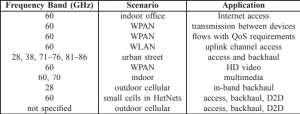What Is mmWave?
Millimeter wave is the band of spectrum between 30 to 300 GHz. it is also known as extremely high frequency. This spectrum can be used for high-speed wireless communications since it is wedged between microwave and infrared waves. As used in with the latest 802.11 and Wi-Fi standard (functioning at 60 GHz).
The U.S. Federal Communications Commission (FCC) has set free approximately 30 times more bandwidth at millimeter-wave frequencies than what is available at cellphone bands for commercial usage. Millimeter-wave spectrum would let orders of magnitude greater throughput. It allows opening important application spaces, for example, virtual reality, where what a user sees is relayed as high definition video back to a server, processed, and augmented with high definition overlays delivered back to the user, all in real time.
mmWave hardware for 5G has unique challenges and required characteristics as compared to hardware for below-6-GHz operation.
Characteristic of mmWave:
- Millimeter wave communications face huge propagation loss compared with other communication systems in terms of using lower carrier frequencies.
- mmWave links are inherently directional.
- Electromagnetic waves suffer from the weak ability to diffract around obstacles with an extremely larger size than the wavelength. Links in the 60 GHz band with a small wavelength are sensitive to blockage by obstacles (e.g., humans or/and furniture).
Challenges and Suggested Solutions:
- The already-existing mmWave technology can approximate to the transmission efficiency possible below 6 GHz on a J/bit basis if beamforming is used to reduce power levels needed. However, this is still not enough to support the greatly increased data rates imagined in a mobile commercial telecommunications system.
- Possible solutions are developing current devices, creating new devices, and developing better measurement and modeling tools to characterize those devices and create more efficient transmitters.
- Many semiconductor technologies present advantages at mmWave frequencies (e.g., SiGe, GaN, GaAs, and CMOS), but the technical hardships and costs linked with integrating these are currently prohibitive. Possible solutions include heterogeneous integration.
- The complexity of beamforming and speed of signal processing in mmWave systems is significantly higher than below 6 GHz.
- Free-space path loss at mmWave operating frequencies
o Possible solutions may include high-density femto/pico cells, scalable and massive array concepts, beamforming arrays, and antenna integration. - Multi-user support of base stations
o Possible solutions include time division multiple access (TDMA), hybrid architectures with subarrays, mmWave MIMO technologies, code division multiple access (CDMA), and frequency division multiple access (FDMA).
o Related hardware requirements include high-power mmWave amplifiers, new active antenna technologies, integrated high-order phase shifters, and measurement traceability for dynamic free-field modulated signals. - Regarding the indoor coverage, mmWave signals will not break through building structures
o Possible solutions may include indoor repeaters and collaboration with gigabit Wi-Fi networks.
o Related hardware requirements include handsets with diversity RF-front-ends that can switch between mmWave, below 6 GHz, Li-Fi, and Wi-Fi networks.
Applications of mmWave

Conclusion:
With the high potential to present orders of magnitude greater capacity over current communication systems, mmWave communications are a promising choice for the 5G mobile networks.
The characteristics of mmWave communications boost the redesign of architectures and protocols to address the challenges. These include integrated circuits and system design, interference management and spatial reuse, anti-blockage, and dynamics due to mobility.
More information on Youtube Channel
REF:
- T. Q. Duong, H. -H. Chen, “Millimeter-wave communicationsfor 5G “.
- S. Y. Geng, J. Kivinen, X. W. Zhao, and P. Vainikainen, “Millimeterwave propagation channel characterization for short-range wireless communications,”.
- A Survey of Millimeter Wave (mmWave) Communications for 5G: Opportunities and Challenges.
